The Acer Nitro 5 Gaming Laptop Review: Absolutely AMD - Ryzen Plus Polaris
by Brett Howse on February 15, 2019 8:30 AM ESTDisplay Analysis
Acer’s Nitro 5 offers a 1920x1080 15.6-inch display which is an IPS panel, which is great to see. Even though this is a value offering, it would have been disappointing to see a TN display, so well done Acer. That is about where the good qualities of this display end, unfortunately.
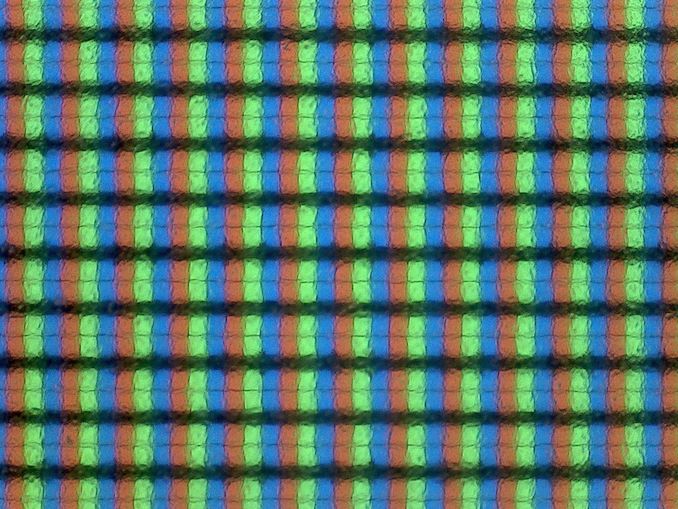 Acer Nitro 5 Subpixels with Anti-Glare coating
Acer Nitro 5 Subpixels with Anti-Glare coating
At 15.6-inches in size, the 1920x1080 resolution does allow you to run 100% scaling without the elements getting too small. That’s a benefit for sure, since you won’t get the artifacts that can still existing when using scaling in Windows 10. There’s been a lot of improvements to the OS to correct this, but not all applications have taken the time to ever deal with it. Luckily that won’t be a concern at 100%.
To test the display we use SpectraCal’s CalMAN suite with a custom workflow. Brightness and contrast readings are taken with the X-Rite i1Display Pro colorimeter, and color readings are taken with the X-Rite i1Pro2 spectrophotometer.
Brightness and Contrast
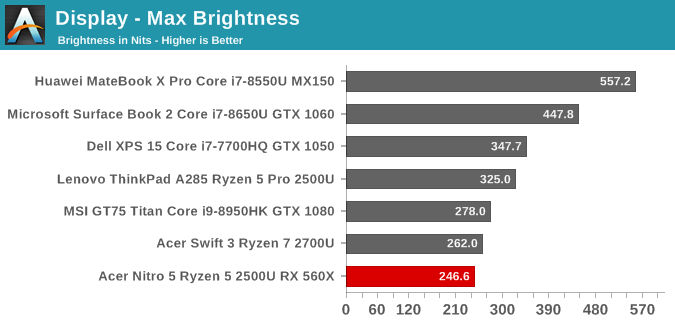
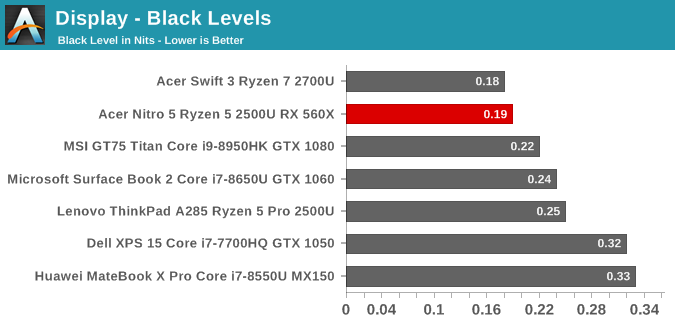
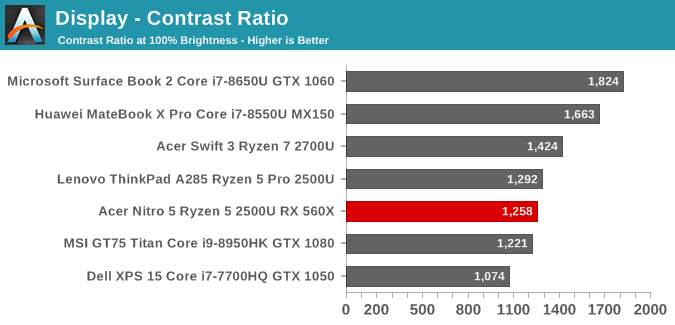
The panel on the Nitro 5 doesn’t get particularly bright, topping out at just 246 nits. It also doesn’t get particularly dark either, with a minimum brightness of 16 nits. But both values are likely fine for use indoors on a desk. The black levels are quite good though, leading to a solid contrast ratio of 1258:1 at maximum brightness.
Grayscale
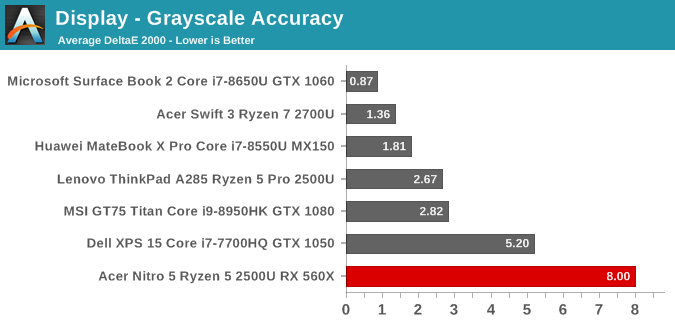
Here is where things start to get unravelled for the Nitro 5. The grayscale accuracy is terrible, thanks to the green part of the backlight being far too bright at almost any point in the range. The gamma curve is also well off the 2.2 value expected, falling increasingly under that point starting at around 35% brightness. This means there will be less of a dynamic range between highs and lows as you go towards greater brightness levels.
Gamut
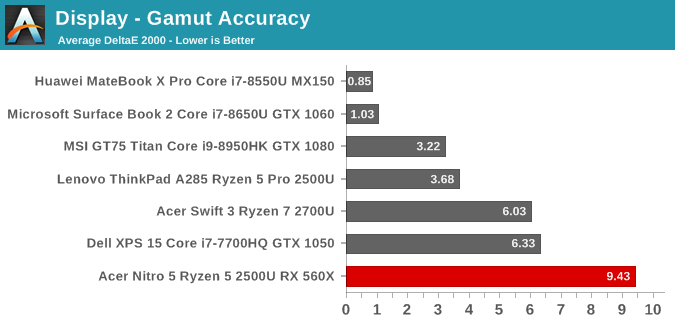
Here we can start to see the problems inherent in this display. The greens are the only colors even close to hitting the sRGB gamut, with red well under and blue doing its best impression of Hawaii. The graph ranges had to be adjusted just to see on the chart how far blue is off the mark, and at almost a dE2000 of 25, it is very, very far from where it should be.
Saturation
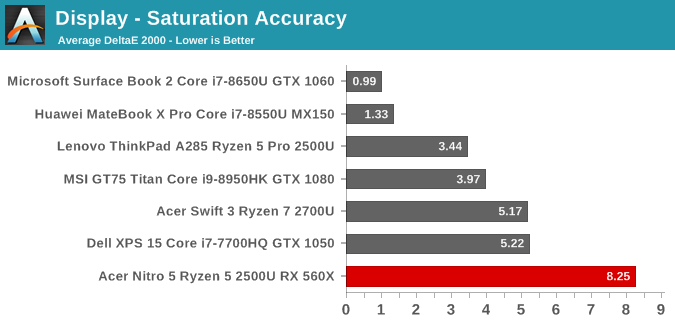
Gamut is the primary and secondary colors at 100% brightness, whereas with the saturation sweep we test with 4-bit steps from 0% to 100%. It’s amazing just how far off the blue levels are, and coupled with the less than amazing reds, the magenta values are also dramatically impacted.
Gretag Macbeth
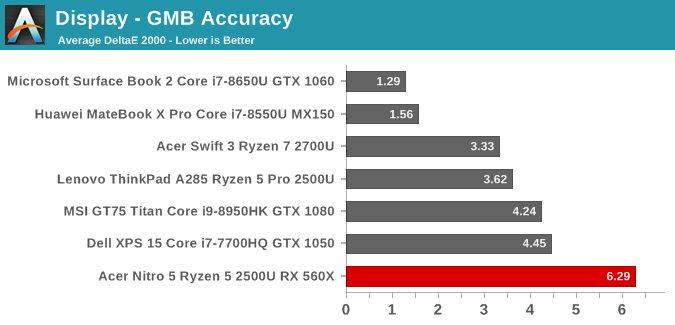
This graph also needed to have almost all of the charts adjusted to show just how far off the mark the colors are on this display. Considering the less than amazing primary colors, it’s no shock that every single color is pretty much terrible.
Colorchecker
This image shows the intended color on the bottom, and the achieved color on the top, so it gives a nice representation of the previous tests. The whites are very green, and the colors are mostly terrible.
Display Conclusion
This display is possibly the least accurate IPS panel we have ever tested. The uncalibrated panel is coupled with a backlight that can’t even come close to covering the entire sRGB spectrum. The Acer Nitro 5 is an entry-level device, and the display is one of the ways they made it to their target price.















90 Comments
View All Comments
GreenReaper - Monday, February 18, 2019 - link
People who are just coming here to find a review of a particular laptop may not know that.I agree that it would be nice to know for sure if it was stuck in single channel, as I seem to recall that being a criticism of its other AMD model. At the same time it's possible that the impact is less given the separate graphics hardware with 4GB dedicated GDDR5.
jgraham11 - Thursday, February 21, 2019 - link
Brett, thank you for commenting back. Bottom line is that when people are choosing a laptop to purchase, most people that don't have an unlimited amount of money or a specific design requirement want to know what they can get with the money they have. By comparing notebooks that are double, triple or more the price and not indicating price so distorts the perception of this product in a negative way. To solve this, label the price of each notebook (you would get crucified for making such outlandish comparisons) or only compare to other notebooks that have a similar price tag.If you don't do that, you are supporting an Intel monopoly, please say that isn't the case.
Annnonymmous - Sunday, February 17, 2019 - link
It actually shows how much of a bargain this laptop is. Why spend all that money when a bargain bin laptop gets you within a similar level of performance. I own this laptop. It won't disappoint you.Vitor - Friday, February 15, 2019 - link
Wow, what a dismal ips display. That's depressing actually.niva - Friday, February 15, 2019 - link
I said to myself:. Wow, finally, an AMD laptop with a good ips display!Then I saw the results. It's clear that unless AMD makes their own machines directly, no manufacturer will get it right.
mr_tawan - Friday, February 15, 2019 - link
Based on my own experience with Acer's machines. ... This is about just right :P.Well I've never come across Acer's machine with good stuffs in it before, they are pretty much all budget-oriented. That said things, might have changed.
TheinsanegamerN - Sunday, February 17, 2019 - link
I've been saying this same thing for years. AMD has had great notebook chips for awhile, but no OEM takes them seriously. They should partner with sapphire or clevo and build a range of proper Radeon-books or such.michaelflat1 - Thursday, February 21, 2019 - link
Clevo and MSI are not going to use AMD's 7nm mobile chips on their release.. so we are out of luck on that front.. some budget laptop chinese companies are locked into a contract with intel, they get cheaper chips but not allowed to sell any amd laptops.. only one amd ryzen embedded laptop to come out of china :( (not regarding matebook D)If AMD's 7nm goes right hopefully we can get a big OEM onboard, microsoft? Dell? Apple!?! that would probably be dreaming..
I think the high idle consumption is keeping them out of high end laptops, and stuff like video playback/streaming on youtube has too much of a hit on battery life.. maybe 7nm will fix this (we hope)
tipoo - Tuesday, February 19, 2019 - link
Yep, manufacturers seem to fall into the trap of them being slightly cheaper than Intel/Nvidia parts meaning they have to penny punch every other component. Would be a pretty great system with a decent display, and preferably dual channel memory, though as noted that doesn't choke a CPU much since this has dedicated VRAM.Oxford Guy - Saturday, February 16, 2019 - link
It would be useful to see calibrated results. Products like the ColorMunki are not expensive.Since the black depth wasn't as bad as some of the other screens here it may be the case where this panel isn't quite so bad with calibration.